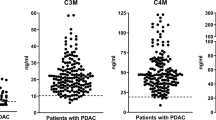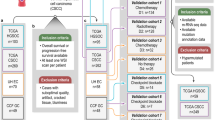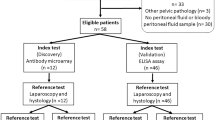Abstract
The synthesis and degradation of type I and type III interstitial collagens releases several antigenic metabolites, whose measurement allows the metabolism of connective tissue to be evaluated under a variety of different conditions. In this study we investigated the influence of benign and malignant ovarian neoplasms on the metabolism of these collagens. The study population comprised patients with benign (n = 53), borderline (n = 6) or malignant (n = 36) ovarian neoplasms. We quantified the serum, cyst fluid and peritoneal/ascitic fluid concentrations of the amino-terminal propeptide of type I (PINP) and III (PIIINP) procollagens, indicators of the synthesis of type I and III collagen, respectively and the cross-linked carboxy-terminal telopeptide of type I collagen (ICTP), an indicator of type I collagen degradation. Macrophage colony-stimulating factor 1 (CSF-1) concentration was also assayed as its serum level is increased in ovarian cancer and CSF-1 may be involved in the regulation of collagen metabolism. The concentration of each antigen was significantly higher in patients with malignant tumour than with benign neoplasm in each comparison, except for ICTP in peritoneal fluid and for CSF-1 in cyst fluid. The high ascitic fluid concentration of PINP, PIIINP or CSF-1 correlated with malignancy, and the low cyst fluid concentration of any of the four markers was indicative of benign tumour. Levels of CSF-1 did not correlate with the levels of any of the markers of collagen turnover. The concentration of PINP in ascites was about 50 times higher and in cyst fluid about eight times higher than that in the serum from patients with malignant tumour, whereas the respective ratios for ICTP were only 2.5 and 1.3. In such patients, the ratio of ascitic fluid to serum concentration was also about 80-fold higher for PIIINP and about 20-fold higher for PINP than for ICTP. The different distributions of PIIINP, PINP and ICTP suggests dominance of synthetic processes or retarded elimination of PIIINP and PINP in ovarian cancer. In advanced malignancies, the accumulation of PINP and PIIINP in abdominal space, possibly due to increased synthesis and/or failed resorption, may promote ascites formation. This study shows that both accelerated synthesis and breakdown of fibrillar collagens are characteristic of ovarian malignancy, and suggests that measurements of cyst fluid or ascitic fluid concentrations of collagen metabolites or CSF-1 could be used in the differential diagnosis of benign and malignant ovarian neoplasms.
This is a preview of subscription content, access via your institution
Access options
Subscribe to this journal
Receive 24 print issues and online access
$259.00 per year
only $10.79 per issue
Buy this article
- Purchase on Springer Link
- Instant access to full article PDF
Prices may be subject to local taxes which are calculated during checkout
Similar content being viewed by others
Author information
Authors and Affiliations
Rights and permissions
About this article
Cite this article
Santala, M., Risteli, J., Risteli, L. et al. Synthesis and breakdown of fibrillar collagens: concomitant phenomena in ovarian cancer. Br J Cancer 77, 1825–1831 (1998). https://doi.org/10.1038/bjc.1998.303
Issue Date:
DOI: https://doi.org/10.1038/bjc.1998.303
This article is cited by
-
A comparative analysis of different biofluids towards ovarian cancer diagnosis using Raman microspectroscopy
Analytical and Bioanalytical Chemistry (2021)
-
UFFizi: a generic platform for ranking informative features
BMC Bioinformatics (2010)
-
Ets factors and regulation of the extracellular matrix
Oncogene (2000)



